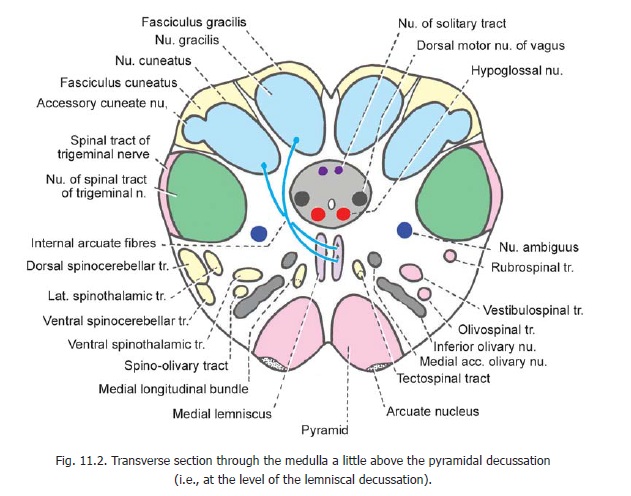Chapter: Human Neuroanatomy(Fundamental and Clinical): Cranial Nerve Nuclei
Medial Longitudinal Fasciculus
Medial Longitudinal Fasciculus
The medial longitudinal fasciculus consists of fibres that lie near the midline of the brainstem. Above, it reaches up to the level of the third ventricle. (Theascending fibres end in the interstitial nucleus of Cajal,the nucleus of the posterior commissure, and the nucleus of Darkschewitsch).
Below, the medial longitudinal bundle becomes continuous with the anterior intersegmental tract of the spinal cord (Fig. 9.2). The fasciculus is closely related to the nuclei of the third, fourth, sixth and twelfth cranial nerves (all of the somatic efferent column and lying next to the midline). It is also related to the fibres of the seventh nerve (as they wind round the abducent nucleus), and to some fibres arising from the cochlear nuclei. In the spinal cord it establishes connections with ventral horn cells that innervate the muscles of the neck (Figs. 11.1 to 11.3,and 11.7 to 11.9).

The fibres that constitute the fasciculus are as follows.
1. Fibres arising in the vestibular nuclei of the same side as well as those of the opposite side. These fibres ascend or descend in the fasciculus to reach nuclei supplying the muscles of the eyeball and neck. These connections ensure harmonious movements of the eyes and head in response to vestibular stimulation.
2. Some fibres of the fasciculus are connected to some nuclei of the auditory pathway. These are the nucleus of the trapezoid body and the nucleus of the lateral lemniscus. Some fibres arising in the dorsal cochlear nucleus are closely related to the fasciculus. Through these connections movements of the head and of the eyes can take place in response to auditory stimuli.
3. The medial longitudinal fasciculus affords a pathway for fibres interconnecting the nuclei related to it. Connections between the facial and hypoglossal nuclei may facilitate simultaneous movements of the lips and tongue as in speech.
4. Fibres from the medial (and other) vestibular nuclei descend in the fasciculus to the spinal cord. These fibres form the medial vestibulospinal tract.






Related Topics